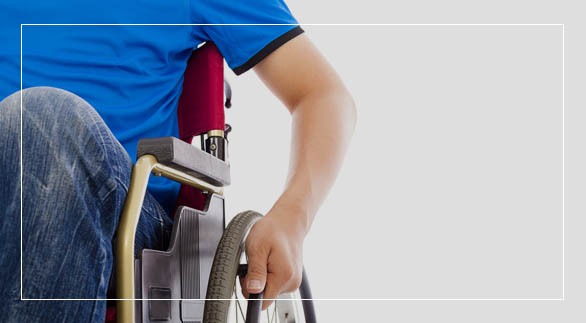Spinal Paralysis
Paralysis is the medical condition where there is partial or full loss of movement, (or sometimes not feel anything) usually in response to an injury, poison, or illness. Spinal cord Paralysis is always the result of nerve or spinal cord damage and not damage to the affected area.
It is when you are unable to move certain body parts after something goes wrong with their connection to your brain. It may occur in various forms and can be short term or everlasting or even come and go.
Someone who has paralysis due to a congenital disability or sudden injury is unable to feel or move anything in their affected body parts.
Paralysis can cause issues with blood flow, speaking, breathing, working of organs, swallowing, walking, sexual responses, or controlling the urge to use the washroom, depending on where you have paralysis and how bad it is. It is said that If you break your spine, you will get paralyzed. Visit Best Spine specialist in Meerut for your spinal paralysis cure.

SPINAL PARALYSIS
The spinal cord is an assembly of nerves and other tissue that the human vertebrae contains and protects. The spinal cord transmits messages from the brain to all parts of the body. It also conveys signals from the body to the brain. Humans are able to recognize pain and move our limbs due to messages transmitted through the spinal cord. Because of a spinal cord injury, some or all of these impulses might be unable to get conveyed. So, as a result, there can be a complete loss of sensation and mobility below the injury site, a spinal cord paralysis. A spinal cord injury that is closer to the neck will generally develop a spinal contusion paralysis affecting a large part of the body than one in the lower back area.
SPINAL CORD INJURY CAUSING PARALYSIS
Your capability to control your limbs after a spinal cord injury depends on two factors:
1. The injury site along the spinal cord and the acuteness of damage to the spinal cord. If all feeling and ability to command movement (motor function) are lost below the spinal cord injury, your damage is called complete.
2. If some of the motor or sensory function below the affected area, your injury is known as incomplete or partial. There are varying degrees of incomplete injury.
Causes of Spinal Paralysis
In the instance of spinal cord injuries, two forms of paralysis are most prevalent:
Tetraplegia, also known as quadriplegia, involves the total loss of movement in the torso, limbs, feet, and hands. It may require artificial respiration assistance, in addition to disturbing the capability to use the bathroom, walk, stand, sit up, and perform similar tasks without help.
Paraplegia is paralysis below the waist, involving both legs. It may affect excretory and sexual functioning, as well as eliminating the ability to walk.
Some impromptu signs and symptoms of spinal paralysis, such as:
- Severe back pain or pressure in the neck, head, limbs, or back
- Fragility, incoordination, or paralysis in any part of the body
- Numbness, tingling, or loss of consciousness in your hands,fingers, feet, or toes
- Unable to control the bladder or bowel.
- Difficult to make a balance and walk
- Difficulty in breathing after injury.
- A peculiarly positioned or twisted neck or back
Paralysis of spinal cord Treatment
A spinal injury paralysis treatment plan will largely depend on the underlying cause of the paralysis, as well as the symptoms experienced by the patient. For example, a doctor may recommend:
- surgery or possible amputation
- physical therapy
- occupational therapy
- mobility aids, like wheelchairs, braces, mobile scooters, etc.
- medications, like Botox or muscle relaxers, if you suffer fromspastic paralysis
In majority cases, cervical spine paralysis cannot be cured. But a healthcare team can prescribe a plethora of treatments, tools, and strategies to help reduce symptoms.
Anyone who experiences severe trauma to his or her head or neck needs immediate medical assessment for the possibility of a spinal injury because:
A severe spinal injury isn't always instantly apparent. If it isn't identified, a more severe abrasion might occur. Numbness or paralysis may occur promptly or come on slowly as bleeding or swelling in or around the spinal cord. The gap between injury and spinal cord paralysis treatment can be crucial in finding the extent and extremity of complications and the potential extent of the expected recovery in the treatment of spinal paralysis.
Physiotherapy treatment for Spinal Cord Injury can help in relieving the symptoms.
The best doctor for spinal surgery must be contacted in severe cases.
Preventing spinal cord injuries
Because spinal cord injuries are often because of unpredictable happenings, the best a person can do is reduce his/ her risk. Some risk-reducing steps include:
- Always wear a seatbelt while driving a vehicle
- Wearing the correct protective gear while playing sports
- Never dive into a water body unless you've made sure it's deepenough and does not have rocks
It is strictly recommended to seek immediate medical treatment to reduce paralysis of the spinal cord effects, at least to some extent. You need a well-learned, experienced, and best spine doctor to provide you with the Best spinal paralysis cure. Why bother when you have the best doctor for Spinal cord Paralysis treatment in Meerut. Visit today, Dr. Amit Bindal, M.S.,M.Ch, Brain, and Spine Surgeon at BINDAL'S CLINIC at Meerut for complete spinal paralysis treatment. He is the best doctor for spine operation in Meerut. For any information, visit www.bindalclinics.com or info@bindalclinics.com.